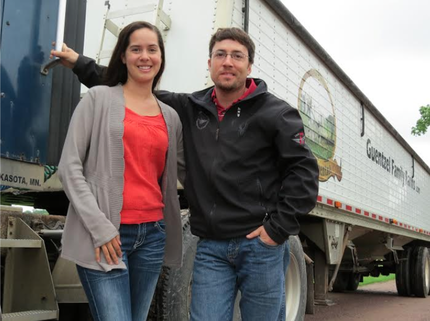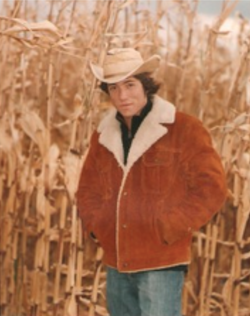A Minnesota Farmer Makes Use of Modern Agricultural Practices to Decrease Chances of Water ContaminationVictoria Gamao & Hunter Irvin
June 13, 2015
 Jon Guentzel and his wife. (Courtesy of Jon Guentzel) Jon Guentzel and his wife. (Courtesy of Jon Guentzel)
In stark comparison to the drought experienced by California this past year, ongoing heavy rainfalls are a pressing concern to small-scale and large-scale farmers alike in the Midwest. Heavy rainfalls have disrupted farming operations and have contributed to soil erosion and water runoff.
Earlier this week, a Pioneer Press news article shared the National Weather Service’s forecast that around 2 to 4 inches of rain would befall southeastern Minnesota. Warnings for a flash flood was issued for the cities and the Minnesota Department of Transportation announced potential for road closures and road access restrictions. Farmers in Minnesota have been feeling the impacts of the occurrences of heavy rains such as this. Jon Guentzel’s family farm is an example of how farmers are responding to this change in weather pattern. “Probably the biggest challenge for us in the more recent years, has been the heavy rainfall amounts coming all in a short period of time, within a day, maybe 5 inches in 12 hours,” says Jon. Jon is a product of a sixth generation family farm in Mankato, MN. The Jon Guentzel family farm primarily produces corn and soybeans for the local community. Its history is of the classic tale of evolution from a small-scale, traditional farm 40 years ago to a large-scale, highly mechanized farm to better meet consumer demands. When asked about the rainfall history in his area, Jon clearly expresses the distinction between the the past and present. “As a kid, very seldom did I see and any kind of soil erosion or runoff in some areas and once these larger rain events started to happen, I very quickly had to put grass waterways in places that I never had to and most of that was simply tied to the topography and drainage in that area where simply too little structure existed to hold the water back at that time period.”  Jon Guentzel. (Source: Jon Guentzel’s
family farm website) Jon Guentzel. (Source: Jon Guentzel’s
family farm website)
According to Jon, the heavy rainfall in early June and mid-May of this year has caused a visible increase in the number of water streams near his fields. A good thing because it affords more irrigation, but a concern because it has made him cautious in how he applies fertilizer in his fields. Jon worries about the increased risk of agricultural runoff and seeks to decrease the chances for water pollution by using sophisticated imaging tools and careful crop management practices.
“What we have done is split our nitrogen application, never incorporating very much in the soil at one time because that soil only has so much nutrient holding capacity. I probably spend well over 120 some hours analyzing nitrogen levels in our soils for all our fields and we do something with an aircraft to map the fields ahead of time … it’s a pretty complex system of trying to use the tools which is fun for me and I like the challenge. It is complicated and challenging that’s for sure but it’s fun.” Jon is currently the manager of TacAero, a company that encourages the use of innovative tools like aerial imaging to more efficiently perform farming practices such as fertilizer application and identification of terrain levels and drainage sites. Surprisingly, when asked about what other big challenges he currently faces as a farmer, Jon shared that he is concerned with the public’s often hugely negative perception of modern farming operations. He expressed concern of how imbalanced the media has historically portrayed farms like his and how that needs to be changed. “One of the most important things is that when people have real questions about agriculture, I would really appreciate them taking the time to go out and ask real farmers. You know, I think that’s the most important thing because most farmers are really open to answering why they do what they do.” Jon adds that this present negative label for large-scale farms is partly their fault as growers because they do not interact with the community enough. This insight makes Jon hopeful in fixing this negative perception. “We’ve done a lot of things to invite people to the farm to give more information about our day-to-day operations,” says Jon after acknowledging that the agency to keep the public well-informed is at the hands of the growers themselves. Farmers are faced with the task to meet consumer demands of resources like corn and soybeans. Challenging weather events and climate disruption demands requires them to be adaptive. Farmers like Jon are leading the charge in the search for solutions to farming in a changing world. And for that, their efforts should be more recognized. ◼ |
| Mapping the Impacts of Global Change: |
